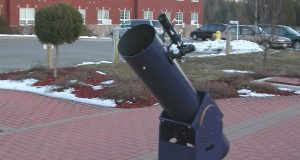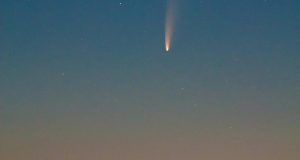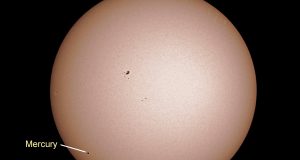As the sun sets in the west, the sky slowly turns pastel shades from light to dark blue. This is my favourite time of evening as the brighter stars and planets begin to reveal themselves. Over the next twenty minutes, more tiny dots emerge like celestial popcorn. About an hour after sunset, the sky is full of stars as ...
Read More »The Backyard Astronomer
Dog Days of Summer
July and August are typically deemed the hottest months of the year in Canada. Nights can be warm and sultry making it difficult to sleep without air conditioning. A term that you might have heard to describe this season of heat is the “Dog Days of Summer”. It begins in the first week of July and could last a couple ...
Read More »When Dinosaurs Roamed
Turn back time to 230 million years ago when dinosaurs began roaming the earth. Some only relied on a plant-based diet while others were meat-eaters. For a long period, they ruled the lands beneath their feet, never knowing a different world displayed above their heads we call the cosmos. Imagine how dark the starry sky must have looked back then ...
Read More »A great conjunction
2020 will be a year that will never be forgotten. For the past months, the entire world has suffered a high level of stress and anxiety from this pandemic. Normal routines of going to work, school, restaurants, concerts, sporting events and movies came to a screaming halt. Other than reading, playing games or binge-watching TV, people began looking skyward, ...
Read More »A Telescope for Christmas
As we move closer to the most wonderful time of the year, what do you get that budding astronomer? I always suggest for those who have an interest in the night sky, to begin with a pair of wide-angle binoculars such as 7X35. This translates to seven power magnification with 35-millimetre objectives lenses located in the front. These are not ...
Read More »Antiquity Meets High Tech
Over the past decades, we have witnessed and embraced the advancement of technology in cars, TVs, computers and cell phones. The list goes on and on. We have the opportunity to learn anything via reputable websites over the internet as well as YouTube videos. Although technology has changed, the night sky has appeared the same for countless millennia. Back ...
Read More »Mars the Red Planet
Over the past few months, the planet Mars has been steadily brightening and is now at its peak. While it takes Earth 365 days to orbit once around the sun, Mars lies farther away from the sun taking 687 days to complete one lap. Every 26 months and an odd number of days, Earth catches up with slower Mars, ...
Read More »Comet Neowise
A bright comet is now in the evening sky and you can see it without a telescope. Comet F3 (NEOWISE) has been a fantastic object in the early morning pre-dawn sky but will be well placed below the Big Dipper to see and photograph over the next couple of weeks and hopefully into August. I have been following and ...
Read More »International Astronomy Day – May 2
The study of astronomy has been around for some 5,000 years and is regarded as the oldest of the allied sciences. Over time, the constellations were created by seeing shapes using a handful of stars appearing close together such as Ursa Major or the Big Dipper. By connecting these stellar dots, celestial shapes came in the form of a person, ...
Read More »Stargazing – A Way To Destress
As we try to cope with the Covid-19 crisis, we must find ways to reduce stress levels and anxiety. Aside from listening to online music and reading books, try stepping outside on a clear night and drink in the night sky. The celestial landscape had been the entertainment of civilizations for thousands of years before the invention of the telescope ...
Read More »Evening Beacon
Throughout history, keen skywatchers would follow the weekly and monthly movement of bright objects against the background sky. The early Greeks referred to the planets of our solar system as the “wanderers” and there are five which can be seen and followed with the unaided eye. The planet Venus is now seen high in the western sky shortly after sunset. ...
Read More »Starbirth
The stars we see on a clear night have been burning for millions or billions of years. But how did they come to be? Stars, like our sun, are created from vast interstellar clouds of gas and dust called a nebula. These stellar objects can measure more than a hundred light-years in length. Over time smaller clouds in the ...
Read More »Mercury to Transit the Sun – November 11 – UPDATED
Nov 13, 2019 @ 08:01 A wonderful video of Mercury transiting the sun on November 11th was shared to Vimeo. The video was shot from NASA’s Solar Dynamics Observatory and shows the transit more than 22,000 miles above Earth. Nov 6, 2019 @ 08:03 Mercury is the closest planet from the sun and orbits once every 88 days. ...
Read More »Seeing Double
Seeing double is never a good thing and a sign to seek medical attention; however, double stars can be a thing of beauty. Some stars that appear as a single point of light to the unaided eye are in fact, double when magnified with binoculars or a telescope. Optical doubles are two stars that appear close together only by line ...
Read More »Perseid’s are underway
The annual Perseid meteor shower is currently underway and will peak on the night of August 12 into the morning of the 13th. The Perseids is the result of earth ploughing through the debris field of Comet Swift-Tuttle when this 26-kilometre wide mountain of rock and ice last rounded the sun in 1992. At its peak, the shower can produce up ...
Read More » Wawa-news.com You can't hear the 'big picture'!
Wawa-news.com You can't hear the 'big picture'!











